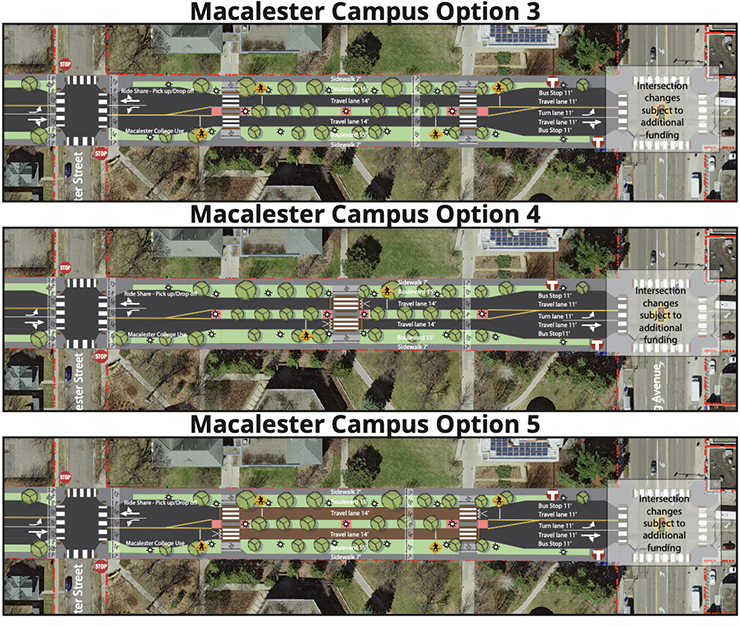For decades, the Grand Avenue crosswalk situation between Snelling Avenue and Macalester Street in St. Paul has been the second most absurd street crossing in the metro area (behind the fiasco at the Cedar Lake Trail in St. Louis Park). But that might finally be about to change.
Here’s the situation: Macalester College isn’t that large, with an enrollment of about 2,200 undergraduates, most of whom live on campus. The campus is a long block-wide rectangle that stretches from Summit Avenue to St. Clair Avenue, and Grand Avenue is the only city street that runs, for one city block, right through campus.
In theory, people are supposed to cross Grand Avenue at the street corners, where the official crosswalks exist. In reality, internal campus paths that cut through though the quad bring almost everyone through the middle of the block. Thus, the vast majority of people use the three “crosswalks” across Grand Avenue, each clearly signed (for legal reasons) so that automobiles — not pedestrians — have the right of way.
The crosswalk impasse is nobody’s idea of a good situation. Because of the lack of curb cuts on the mid-block “crosswalks,” crossing the street through the heart of campus is not only awkward, but onerous for anyone with limited mobility. That’s why it’s good news that St. Paul Public Works is reconstructing a half-mile of Grand Avenue, including the block through Macalester College. If done right, it’ll transform the absurd relationship between cars and people so that the troublesome block no longer relies on vague, unpredictable goodwill.
Convoluted signage
“It’s a super-well-traveled part of campus,” Zak Yuhdishthu told me, describing how Grand Avenue fits at Mac. Yuhdishthu is a senior who’s been actively engaged with the neighborhood process and even tabled outside the student union, gathering input from his classmates.
“It’s the division between a big block of dorms and everything else,” Yuhdishthu said. “Anyone living on campus, to get food to go to class to study any of those things, they’re crossing at that intersection.”
Luckily, most drivers stop for students to cross the street. This makes the actual crosswalks a bit of a gray area: state law gives pedestrians right-of-way at all crosswalks, but not at mid-block quasi-crosswalks. Because these crossings fall into the latter category, they’re not official and drivers don’t technically have to stop. Thus the convoluted signage, which most everyone blissfully ignores.

It’s important to note that foot and car traffic is not evenly distributed. During class changes, hundreds of students swarm from the classroom buildings, and it can be a few minutes of waiting for the stream of students to cease. That’s when tempers flare.
“One of the most frustrating things is [that] you’ll have a long line of students going across the street, and I have seen cars just lay on the horn,” Yuhdishthu, the student, told me.
It wasn’t alway this way. When Macalester was first built here back in the 1880s, Grand Avenue was a dirt street, maybe even full of bicycles, and when the streetcar finally came through the neighborhood, it ran through the middle of campus. But in that era, streetcar streets had a more pedestrian character. They were almost an amenity for students walking around the grounds.

That was never a good situation, for drivers nor students. Shifting the street design dynamics around Macalester College has long been a goal, especially after three different students were killed or seriously injured by drivers around the edges of campus, on Snelling and Grand Avenues, in 2012 and 2014.
A decade later, the city is finally planning a full reconstruction of the street, slated to begin in 2024. A reconstruction allows city engineers to redesign the entire right-of-way from scratch. In theory, planners can create a safer, slower landscape. The city released plans earlier this year, and the Grand Avenue designs have bump outs on the corners to slow cars, along with expanded sidewalks and boulevard space.

It would also be nice to narrow Grand Avenue on the commercial streets to the west, where both sides of the street boast thriving businesses and shops. There’s no reason why the asphalt on Grand Avenue needs to be 48 feet wide.
“That would be a huge deal,” said Yuhdishthu, referring to the raised table (where the street comes up to the curb’s level) of Option 5. “It would make it easy to cross, and hopefully be a clear signifier to drivers that you’re on a college campus — the rules and expectations are different.”
This problem isn’t unique to Macalester, and other colleges face the same tensions. Higher education can be an internally-focused bubble, dense places where most everyone walks, but often surrounded by ubiquitous high-speed roads. Getting that balance right can be a lost cause, but in many recent examples — most notably the University of Minnesota’s East Bank campus — engineers have dramatically slowed car traffic and prioritized people on foot.
If it happens, the change through the Macalester College will be a huge improvement. It’ll quickly change the way that people walk and drive around the campus greens.
“A lot of Macalester students haven’t thought explicitly about urban design, but they feel the discomfort, ” explained Yuhdishthu, after he tabled and talked to his fellow students. “The cars speeding by, it’s an intuitive thing. When you’re crossing the street, when they think about it, they have similar complaints as I do.”
If it works, the transformation at Macalester will be swift, one of the brilliant things about college campuses. By the time the school year starts in 2024, new students will never know about how stupid the street crossing used to be. Within a few years, an entirely new group of undergraduates will be strolling across a new and improved Grand Avenue, and nobody will even remember what once was.


0 Commentaires